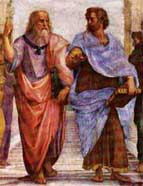|

|
Plato
(428-348/347 B.C.E.)
 |
| Plato
points to the heavens, his student Aristotle to the ground, in Raphael’s
painting of the School of Athens (detail).
|
Plato's
philosophy and its implications
for Greek cosmology are understandable as a response to social and political
troubles. Plato was of an age to enter public life when the Thirty Tyrants,
including two of his relatives, ruled Athens. Their actions disgusted
Plato. When their rule was overthrown, Plato again considered joining
the government. But then the democracy persecuted his teacher and friend
Socrates. Subsequent experiences, perhaps including an encounter with
the dictator of Syracuse, confirmed Plato's dismay over the actions of
rulers. He searched for unchanging standards to hold against the shifting
judgments of men.
|


